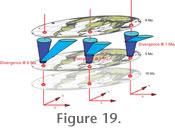| |
CONCLUSIONS AND OUTLOOK
 Automated specimen orientation and image collection with AMOR opens new possibilities for obtaining extended morphometric foraminiferal data sets for evolutionary studies. Replacement of a human operator by an automat reduces variability of measurement and human error. The speed of specimen throughput is enhanced with AMOR, although the results must always be critically supervised. Application of AMOR to record morphological shell change through geological time and along geographic or (paleo-) climatological gradients gives way for statistical analyses at greater sampling density than before. It allows for a more complete exploration of the morphological speciation and divergence patterns and ecophenotypic variation buried in the sedimentary record on a global scale (concept of "evolutionary exploration", see
Figure 19). Until present AMOR was extensively tested using the Globorotalia menardii foraminiferal plexus, but other foraminiferal species groups can be analysed with the system as well. Automated specimen orientation and image collection with AMOR opens new possibilities for obtaining extended morphometric foraminiferal data sets for evolutionary studies. Replacement of a human operator by an automat reduces variability of measurement and human error. The speed of specimen throughput is enhanced with AMOR, although the results must always be critically supervised. Application of AMOR to record morphological shell change through geological time and along geographic or (paleo-) climatological gradients gives way for statistical analyses at greater sampling density than before. It allows for a more complete exploration of the morphological speciation and divergence patterns and ecophenotypic variation buried in the sedimentary record on a global scale (concept of "evolutionary exploration", see
Figure 19). Until present AMOR was extensively tested using the Globorotalia menardii foraminiferal plexus, but other foraminiferal species groups can be analysed with the system as well.
Apart from micropaleontological applications, AMOR may have potential for quality control of microscopic particles in all sorts of powders (washing powder, cosmetic powder, concrete powder), beads, sands, plant seeds, pigments, etc., i.e., in cases where orientation plays a role in discrimination of shape parameters.
|